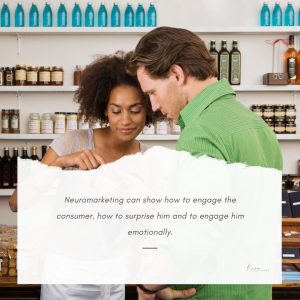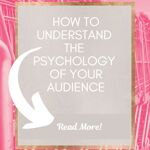Psychographics and neuromarketing are terms used to describe parts of our psychology as they apply to marketing. Understanding the psychology of our audience means that we can move past features and benefits to engaging what really drives our audience to take action.
Understanding the psychology of our audience means understanding the science of “Know, like, and trust”. In business we often hear that our clients will buy from us if they know, like, & trust us/our brand. But how do we make it happen? If we look at why, as people, we know, like, and trust people it comes down to a few things. Similarities, bonds, and a mutual exchange. So what about your audience? How do you develop the know, like and trust and understand their psychology?
Understanding audience psychology on social media
When it comes to social media, there are three key chemicals in our brain that are triggered when we are online: oxytocin, dopamine, and cortisol. These chemicals are all involved in our emotions. They all have an effect on the part of the brain responsible for motivated behaviour – the centre of what we do what we do.
When we want our audience to do more, it’s important to understand what activates these centres and how we can influence that.
Let’s quickly run down what each of these chemicals do.
Oxytocin
Responsible for bonding a parent and child. Often called the love drug. Oxytocin is involved in empathy and trust. It has been shown to decrease the release of cortisol and anxiety related to social stress. It’s also seen in jealousy, gloating, and discrimination against those outside of a group (Out-group discrimination).
So it seems that oxytocin is what brings us together and keeps us together.
Dopamine
I often refer to dopamine as the “drug of addiction” as it’s responsible for forming addictions, but that’s a rather simplistic view. It’s released when we experience pleasurable activities, released when we are seeking pleasurable activities, and it’s what keeps us addicted.
Dopamine helps us focus, pay attention, and store things in short-term memory.
Dopamine also helps us in social situations.
Cortisol
We commonly know cortisol as the “flight or fight” hormone. It also has a role in attention and memory. Its primary role is to increase the energy available in the body.
There is some evidence to show that there is a greater impact of cortisol when we are in familiar situations than new situations.

So now you know what is happening in the brain of your audience, how do you use it to impact their psychology?
Sociologists discovered that the audience’s engagement with a brand is dependant on their needs, motives, and goals. I’ve expanded that to fears, needs, beliefs, values, and goals.
I included fears because we know that cortisol and oxytocin are related to fear and that fear marketing does work.
I included beliefs & values as they are the construct that guides many of our actions. It could range from religious beliefs to buying local. Neither are needs but they are motives.
How do you discover the psychology of your audience?
When you are doing this research, it’s important to remember that this is what their psychology is in relation to your product or service. Your aim is to get them to buy more with you and so it’s important to focus on their psychology in relation to what you do.
In the first instance, go back through your notes, emails, reviews, testimonials, and feedback. Look at comments on your blog and on your social media channels. Gather it all together and categorise it into a fear, need, belief, value, or goal.
What are their fears?
When it comes to your product or service, what do they fear? Are they afraid it won’t be good quality? Afraid it won’t be delivered on time? Afraid that it will be lost or broken in transit? Afraid that it won’t help? What are the frequently asked questions you receive or in your industry that relate back to a fear around what you do? How do you solve it?
You may see a lot of these fears written on landing or sales pages. Marketers will often put these up the top to agitate an audience. They then go on to demonstrate how the business solves them.
We commonly think of FOMO (Fear Of Missing Out) and Limited Time/Edition as fear marketing, but there is more to it than that. Not to mention that most audiences are tired of this tactic because it’s not always true.
What are their needs?
This is where features and benefits traditionally “fall”, but it goes deeper than that. I tend to use Maslow’s Hierarchy of Needs: safety, physiological, love/belonging, self-esteem, and self-actualisation (being all you can be). I use it because it’s broad and widely known.
Using these broader needs doesn’t discredit features and benefits in marketing, what it means is that you’re able to show your audience that you understand their broader needs and they no longer have to guess if you will meet them.
How do you know what their needs are? They will tell you, you will hear it in their feedback, or you can survey them.
What are their beliefs?
Does your audience like to shop small or shop local? Are they vegan or vegetarian for religious reasons? Do they have any other religious beliefs that govern what or when they buy? These are just some of the beliefs that can dictate our behaviour as shoppers.
What are their beliefs about you, your brand, your product, or services? Do they believe they can’t afford it? Do they believe that it’s a luxury purchase or holds status?
Beliefs are thoughts that we hold as truths and are based on our lived experiences.
How does this apply to your audience and what you sell?
How do you know what your audience’s beliefs are? You could ask, but it’s easier to listen to the types of questions they ask and from there you can either start a conversation about their beliefs or you will be able to work them out.
What are their values?
You’re probably wondering how a value differs from a belief. They’re universally understood, which means that our lived experiences do not influence them. Think of honesty, integrity, trust, courage, family (remember family is what you make it). These are values.
Does your audience value timeliness, honesty, quality, family as it relates to your brand, product, or service? Is integrity important to them? There are many other values.
So how do you know what their values are as they relate to what you do? Like beliefs, they will tell you – subtly. You could tell them what values your company holds and see how they react. Do a poll. Remember that values are verbs and are best demonstrated rather than mounted on the wall.
What are their goals?
What are their goals when it comes to what you’re going to provide them? Do they expect it to be durable? Do they want to feel a certain way? There are so many things they can want from what you do, but it has to be what they say they want.
Not sure? Read the 2 & 3 star reviews of competitors, industry books, or even your own reviews to see what customers said was missing.
Key takeaways about understanding the psychology of your audience
- It’s all about them as it applies to what you do. They need to be at the centre as they are the people you need to influence to take the action. Understanding what drives that action, their psychology, is key.
- The answers are all around you. You don’t have to survey. Look at the data that’s already there.
- Colours psychology, copywriting, pricing psychology and other neuromarketing tactics rely on you understanding what motivates your audience first.
- The more closely aligned a client is to a brand, the more they will buy from them.
- Start with what drives their action, understand and build on what drives their “know, like and trust”.
Want a deeper understanding of the psychology of your audience?
Here are some additional resources:
The psychology of engaging content
Checklist for writing engaging social media
How to get inside your client’s mind without a psych degree
How psychology is important to online business
The psychology behind staff & client drivers
Ethics & the psychology of Facebook
20 ways to deliver exceptional customer service – with free checklist
Psychology of odd and even pricing
References
Cochran, D. M., Fallon, D., Hill, M., & Frazier, J. A. (2013). The role of oxytocin in psychiatric disorders: a review of biological and therapeutic research findings. Harvard review of psychiatry, 21(5), 219–247. https://www.ncbi.nlm.nih.gov/pmc/articles/PMC4120070/
Mandal, A. (2019). Dopamine Functions. News Medical Life Sciences. https://www.news-medical.net/health/Dopamine-Functions.aspx



